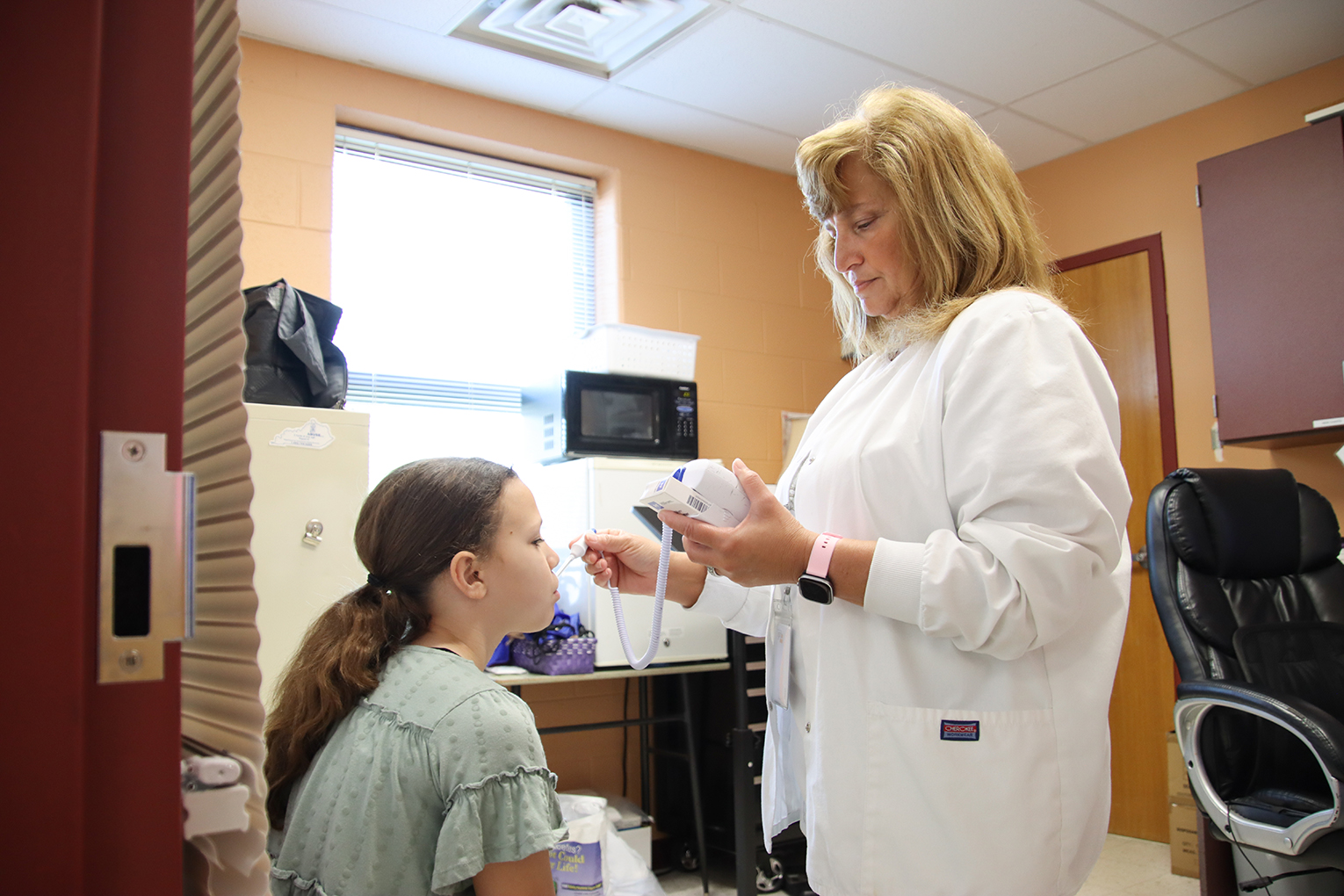
KW Sexton helps a 4th-grade student with a geometry equation during his class at Star Elementary School (Carter County).
Photo by Amy Wallot, May 14, 2014
By Susan Riddell susan.riddell@education.ky.gov
When Star Elementary School (Carter County) earned a 2013 National Blue Ribbon School honor, it was the first Blue Ribbon honor for the school district.
Principal Charles Baker said that while the award was an indication of strong teamwork at his school, he doesn’t want staff and students to think their work is done.
“This honor really says to us that when people put in the work and they work together, you can reach success,” said. “Getting recognized by the state and nation is a pinnacle, but we don’t want to slack off. We’ve got a commitment to the kids to raise the bar.”
District instructional supervisor Judy Dotson said that aside from the district setting high expectations for all its elementary schools, Star Elementary succeeds because of “a strong intervention program, focused professional learning and an intentional and collaborative process for implementing Program Reviews.”
In completing Program Review work, Star has focused efforts on community involvement, especially in regard to its Practical Living Program Review and arts and humanities emphasis. Star has reached out to its community for learning opportunities, setting up a career day and bringing in The Big Smile Dental Program and educating students on the importance of not using drugs, alcohol and cigarettes. “This provides opportunities for many business leaders to be involved at Star Elementary, and there’s a certified dance instructor who provides dance instruction covering all the dance disciplines for every student in the school,” Dotson said. “The Program Review implementation process at Star has really contributed to high performance.”
Collaboration is vital at Star Elementary, Dotson said, because of the small size of the school. Serving preschoolers through grade 5 students, each class functions as a grade level, making vertical alignment the basic internal form of collaboration. Additionally, teachers rely on professional learning opportunities.
“The small school setting makes it difficult for teachers to have grade level professional learning communities (PLCs),” Dotson said. “Therefore, the staff participates in districtwide professional learning communities. Each month the teachers attend grade level sessions to review data, plan instructional strategies and reflect on teaching practices.
“Also, Star has placed an emphasis on implementing the Framework for Teaching. Each month teachers participate in a domain and component specific session focused on improving instruction,” Dotson added. “Teachers self-reflect on current practices in relation to the domain component of study for the month. They participate in calibration exercises using Teachscape videos. Follow-up walkthroughs are conducted to observe the implementation of the monthly domain and component.”
Lisa Hicks, who has taught at Star Elementary for 14 years, said that it helps her instruction and meeting student needs when teachers meet as a team and collaborate between grade levels. An example of this collaboration is the school’s common reading block.
“All classrooms teach reading at the same time,” Hicks said. “This allows students to move up or down grade levels for instruction that challenges, supports and better meets individual learning goals. Additionally, teachers with adjoining grade levels have common planning periods so that they may have PLCs with one another, plan units and share ideas.”
Hicks said that teachers also participate in monthly Reading Academy meetings where they share ideas, learn new teaching strategies and discuss Response to Intervention (RTI) techniques as well as other valuable topics.
“Utilization of student assessments and creating individualized RTI plans and instructions to meet the needs of all students” is point of pride for Star teachers Hicks said, along with providing high quality additional support and enrichment for students already meeting proficiency goals so that they may aim even higher toward distinguished status.
“Our teachers teach concepts rigorously by requiring students to understand concepts more deeply and apply their knowledge to real world situations,” Hicks said. “Teachers make sure that all students are actively engaged. We do not allow our students to opt out, zone out, cop out or sit idle. Everyone participates in the learning experience. This requires teachers to constantly monitor during lessons and activities, have strong classroom management plans and enforce consequences when students are not actively on task.”
Both Baker and Dotson praised Star Elementary teachers and staff, especially their ability to get to know each student in a unique and caring way.
“While Star attributes its success to the programs that are being implemented, the true success is due to the staff in the building,” Dotson said. “Everyone in the building is engaged in helping students to learn and reach their fullest potentials.”
“We make connections with every child who walks into this building,” Baker said. “Teachers make sure to do this early and build on it so there are successes at every level. It’s great to watch this, knowing that the children will leave here well prepared for their futures.”











Leave A Comment